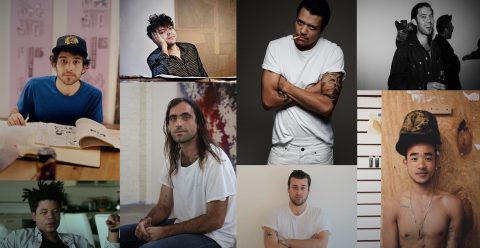How auctions have been shaping the emerging art scene
- …
It is a matter of fact that the generation of artists born during the Eighties is the first one in history facing public sales since the very beginning of their career, along with a massive circulation of data regarding the pieces sold, or indeed unsold for that matter. And considering how deeply this new phenomenon has been influencing this part of the art system for the last three years, the time has come to attempt to make some remarks.
The new era began circa 25 months ago, precisely on 15 May 2013, when a painting by Oscar Murillo (Untitled, Synthetic Trash Paintings, 2012) went under the hammer at Sotheby’s in New York for €23.000. At that time the Colombian artist – now represented by the leading gallerist David Zwirner, and also included by curator Okwui Enwezor in the Venice Biennale – was only 26 years old. That is to say just one year younger than Damien Hirst when his first piece was sold at Sotheby’s (1992), but ten years younger than Jeff Koons and twenty-eight than Gerhard Richter when they were auctioned for the first time.
When, a month after Murillo’s first sale, a piece by Hugh Scott Douglas went under the hammer (Phillip’s, 28 June), the Canadian artist was 23 years old. While Lucien Smith was only 22 when his painting titled “Hobbes, The Rain Man, and My Friend Barney / Under the Sycamore Tree” sold at Phillip’s for €291.000. It was 11 November 2013. In the same auction there were also pieces by contemporary masters such as Jeff Koons, Andy Warhol, Cy Twombly, Ed Ruscha, Mark Grotjahn and Wade Guyton. The last lot was a piece by Murillo that went for 293.000 USD, almost doubling the estimate.
From then onwards many other artworks by “younger than Jesus” artists have been auctioned, especially by Phillip’s, quickly turning their authors into art celebrities, yet in a rather different way from that that made Jacob Kassay sadly famous in 2010 as a mere speculative phenomenon. For Murillo and Smith, but also for Nick Darmstaedter (b. 1988), Louis Eisner (b. 1988), Sam Falls (b. 1984), or Wyatt Kahn (b. 1983) public sales that took place between 2013 and 2014 have most of all reflected the extraordinary interest the market had in their works at that moment in time, and even if nowadays that market is not as excited as it was, it is another matter of fact that many art buyers and collectors have come to know these names very well, making the secondary market blossoming – yes, excessively. But now the question is, which group or solo show, or art institution too, could have accomplished so quickly similar results in terms of promotion? Probably none, because when dealing with emerging artists the price is today more than ever the most impressive related information.
Since Spring 2013 Murillo sold at auction a total of 63 works, Lucien Smith 58, Sam Falls 35, Hugh Scott Douglas 26. Buyers will not forget about these volumes that easily, even if it might take a long time for these artists – still very young artists – to be “certified” by the art institutions, called into cause to rate that same artists the auctions have already made famous and well paid anyway.
But in regards with the role that institutions are going to play it must be said that having their support, without that of the market, won’t possibly be enough for a young artist to emerge. The benefits Murillo is experiencing from being invited by Enwezor to the Venice Biennale are not the same of the many never-auctioned artists presented in the same context. Those who were betting against Murillo now have to bet also against Enwezor, Zwirner and Venice too. On the other side, betting against a curator or a dealer is safer if no high prices and volumes on the background.
It follows that, even if since the beginning of 2015 the emerging-artists-market has become more and more prudent, that doesn’t mean that this important part of the new generation is already lost. It is most likely that those among them who will be able to seduce art institutions will be placed in a better position than those artists who might be exhibited in museums, but without having been auctioned. In the on going negotiation between artists’ supporters and institutions sharing the power over emerging art appears to be the best option to adopt for the fututre.
September 14, 2015

